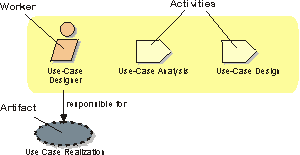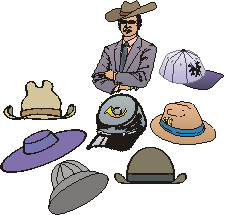Workers Overview
A worker defines the behavior (i.e. activities) and
responsibilities (for artifacts) of an individual, or a set of individuals working
together as a team. Each worker has a set of cohesive activities associated with it.
"Cohesive" in this sense means those activities best performed by one
individual. The responsibilities of each worker are usually defined relative to certain
artifacts.
You could regard a worker as a "hat" an individual can wear in the project. One individual may wear many different hats. This is an important distinction because it is natural to think of a worker as the individual or team itself, but in the Unified Process the worker is more the role defining how the individuals should carry out the work. The responsibilities we assign to a worker includes both to perform a certain set of activities as well as being owner of a set of artifacts. Note: workers are not individuals; instead, they describe how individuals should behave in the business and what responsibilities these individuals should have. The most important role played by people outside of the development organization is to be stakeholders of the project or product to be developed. |
WorkersAny Worker |
![]()

